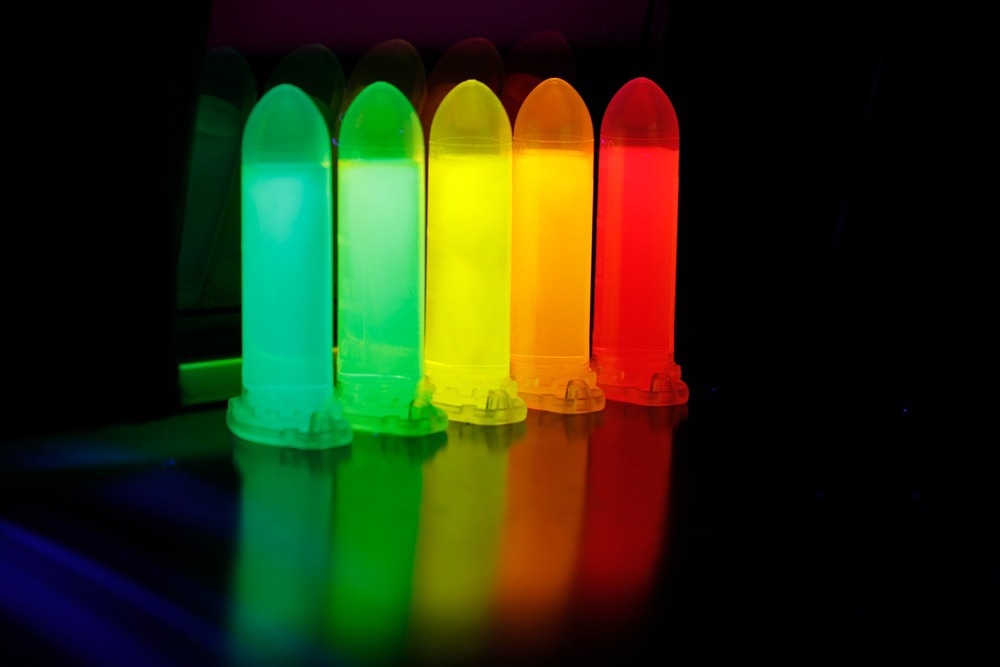Mercaptopurine (6-MP) is used to treat leukemia and autoimmune diseases. However, higher levels of this drug in body fluids may cause severe health problems. In an article recently published in the journal ACS Biomaterials Science Engineering, researchers prepared a ratiometric fluorescence method based on carbon quantum dots to detect 6-MP in human body fluids.

Study: Intrinsic Dual-Emitting Carbon Quantum-Dot-Based Selective Ratiometric Fluorescent Mercaptopurine Detection. Image Credit: Dzmitry Melnikau/Shutterstock.com
Carbon quantum dots were made from carbon sources (glutathione and formamide) via an easy microwave method. The monodispersed carbon quantum dots had a high affinity towards 6-MP and exhibited dual fluorescence emission. The sensor's response was optimized by adjusting the probe parameters (pH, temperature, and volume).
The ratiometric fluorescence analysis showed a concentration range of 1.4 to 7.6 milligrams per liter 6-MP in aqueous solutions with a limit of detection (LOD) of 1.3 milligrams per liter. The performance assessment of the designed sensor using human urine and plasma samples, and complex solutions showed a recovery rate of 88 to 127%.
Carbon Quantum Dots in Fluorometric Sensors
Carbon quantum dots are easy to prepare and have found their applications in optical and biomedical fields. The photoluminescence emission of carbon quantum dots and their facile surface functionalization make them a promising candidate for fluorometric optical sensors. While surface functionalization of carbon quantum dots with hydroxyl, carboxyl, or carbonyl functional groups enables their facile dispersion in the aqueous medium, other functional moieties can facilitate analyte-based selectivity.
Consequently, several fluorometric sensors were developed based on carbon quantum dots to determine the presence of various chemical and biochemical species. Due to their sensitivity, carbon quantum dots-based fluorometric sensors are considered better alternatives to conventional detection methods like high-performance liquid chromatography (HPLC), Raman spectroscopy, electrophoresis, and mass spectrometry.
Moreover, fluorometric sensors avoid the requirements of expensive equipment, sophisticated sample preparation, expert operators, and toxic solvents. Furthermore, ratiometric fluorescence sensors enable the measurement of intensities of multiple wavelengths with high accuracy and response stability, which is favorable in detecting various drug molecules.
The dual-emissive carbon quantum dots are more efficient than their single-wavelength counterparts and are prepared using the thermal or hydrothermal-based element doping method.
Carbon Quantum Dot-based Ratiometric Fluorescent for 6-MP Detection
In the present study, the developed ratiometric fluorescence detection technique to detect an immunosuppressive drug, 6-MP, used to treat autoimmune diseases and leukemia, was based on carbon quantum dots. The too low or excess presence of this drug in body fluids could cause severe health problems. Hence, monitoring its levels in the human body is critical, necessitating a robust analytical technique, which is highly sensitive to 6-MP.
The designed carbon quantum dots-based ratiometric fluorescence detection could analyze 6-MP in human plasma and urine samples. The carbon quantum dots required for the present study were prepared from glutathione and formamide via a microwave-assisted synthesis. Furthermore, the synthesized carbon quantum dots were characterized using Fourier-transform infrared spectroscopy (FT-IR), transmission electron microscope (TEM), and X-ray photoelectron spectroscopy (XPS).
The FT-IR spectroscopy revealed the surface chemistry of the synthesized carbon quantum dots. The resulting spectra showed a broad absorption band between 3000−3500-centimeter inverse, corresponding to the hydroxyl (O-H) and amine (N-H) stretching vibrations. Peaks between 2800-2900-centimeter inverse were related to the methylene (−CH2) group stretching and bending vibrations. The stretching vibration for carbonyl (C=O), alkene (C=C), and imide (C=N) were observed at the 1661.8-centimeter inverse.
The stretching vibrations of amide (C-N), alcohol (C-OH), and C-O were observed at 1384.40, 1296.87, and 1047-centimeter inverse, respectively. Thus, the FT-IR spectra confirmed the presence of amide, hydroxyl, and amine groups on the surface of carbon quantum dots. TEM images showed the carbon quantum dot’s encapsulation within the biological compounds used during their synthesis.
The average particle size of carbon quantum dots was around 3 nanometers, indicating the successful synthesis of ultrasmall, monodispersed carbon quantum dots. Furthermore, XPS revealed the presence of sulfur and nitrogen groups on as-synthesized carbon quantum dots that aided in interactions between the 6-MP drug and carbon quantum dots probe.
Conclusion
To summarize, carbon quantum dots of 3 nanometers particle size were prepared via an easy microwave method from glutathione and formamide. The prepared carbon quantum dots were selective towards 6-MP and showed dual fluorescence emission with a concentration range between 1.4 and 7.6 milligrams per liter.
The interactions between the 6-MP drug and carbon quantum dots probe were due to the thiol and amine groups passed on from glutathione. The fluorometric method measured the concentration of 6-MP in aqueous solutions with high accuracy and LOD of 1.3 milligrams per liter. Despite the presence of interfering agents such as sodium sulfate (NaSO4), sodium chloride (NaCl), ferric chloride (FeCl3), arginine, and fructose up to the concentration of 1000 milligrams per liter, the reported fluorometric method could maintain high precision.
Measuring biological samples like plasma and human urine with different concentrations of 6-MP using the carbon quantum dots-based fluorometric method resulted in drug recovery values in the range of 88 to 127%. The precision and reliability of the designed sensor's performance were confirmed by conducting intraday and interday measurements. The dual fluorometric technique developed in the present work is a better alternative to conventional methods used for drug molecule detection in an aqueous medium, with the potential for parameter tunability to determine other biochemical or chemical species.
Reference
Saboorizadeh, B., Zare-Dorabei, R. (2022). Intrinsic Dual-Emitting Carbon Quantum-Dot-Based Selective Ratiometric Fluorescent Mercaptopurine Detection. ACS Biomaterials Science and Engineering. https://pubs.acs.org/doi/10.1021/acsbiomaterials.2c00423
Disclaimer: The views expressed here are those of the author expressed in their private capacity and do not necessarily represent the views of AZoM.com Limited T/A AZoNetwork the owner and operator of this website. This disclaimer forms part of the Terms and conditions of use of this website.